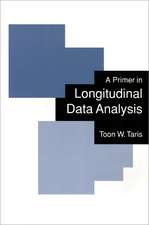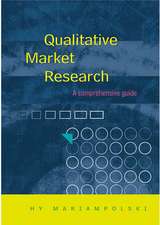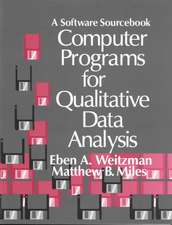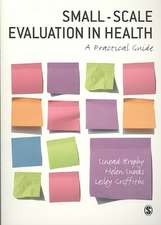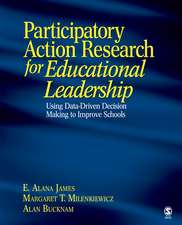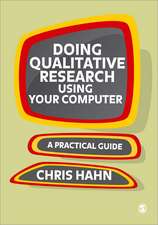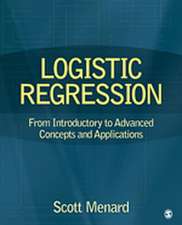Qualitative and Mixed Methods Data Analysis Using Dedoose: A Practical Approach for Research Across the Social Sciences
Autor Michelle Suzanne Salmona, Eli Lieber, Dan James Kaczynskien Limba Engleză Paperback – 6 noi 2019
Preț: 406.61 lei
Preț vechi: 521.30 lei
-22% Nou
77.83€ • 84.57$ • 65.42£
Carte disponibilă
Livrare economică 31 martie-14 aprilie
Livrare express 14-20 martie pentru 30.39 lei
Specificații
ISBN-10: 1506397816
Pagini: 280
Dimensiuni: 187 x 232 x 16 mm
Greutate: 0.48 kg
Ediția:1
Editura: SAGE Publications
Colecția Sage Publications, Inc
Locul publicării:Thousand Oaks, United States
Recenzii
“Great overview of Dedoose® tools and mixed methods functionality make this a great book for beginners.”
Cuprins
Preface
Acknowledgments
Glossary: Dedoose Common Terms
About the Authors
PART I FOUNDATIONS OF MIXED METHODS RESEARCH
Chapter 1 Using Mixed Methods and Dedoose
1.1 About This Book
1.2 Mixed Methods and Mixed Paradigms
1.3 Using Cloud Technology to Support Mixed Methods Research
1.4 What Is Dedoose?
1.5 Dedoose: A Historical Journey
Chapter 2 Adopting Dedoose
2.1 Successful Adoption of Digital Tools
2.2 Framing the Purpose and Focus
2.3 Dedoose: Starting Your Project
2.4 Case Study: Using the Five-Level QDA® Method With Dedoose
Chapter 3 Bringing Data Into Dedoose
3.1 Gathering Mixed Data
3.2 Numbers as Data
3.3 Memos as Data
3.4 Case Study: Incorporating Mixed Analysis Into Your Study
3.5 Conclusion
Appendix: Types of Interview Data
PART II DATA INTERACTION AND ANALYSIS
Chapter 4 Teamwork Analysis Techniques
4.1 Team Management
4.2 Collaborative Interpretations
4.3 Coding in Teams
4.4 Bringing Procedures Into the Dedoose Environment
4.5 Team Conduct Rules
4.6 Case Study: Large-Scale, Multilanguage, Cross-Cultural Analysis With Dedoose
4.7 Conclusion
Chapter 5 Qualitative Analysis
5.1 Qualitative Analysis: Looking for Quality
5.2 Working With Codes
5.3 Case Study: Using Dedoose for a Multisite Study
5.4 Conclusion
Chapter 6 Designing Mixed Methods Analysis
6.1 Identifying Analysis Strategies
6.2 Using Descriptors
6.3 Topic Modeling
6.4 Case Study: Integrating Mixed Data in a Longitudinal Study
6.5 Conclusion
Chapter 7 Managing Complex Mixed Methods Analysis
7.1 Recognizing and Managing Complexity in Analysis
7.2 Data Complexity in Your Project
7.3 Using Visualization Tools for Analysis
7.4 Moving Through and Filtering Your Data
7.5 Case Study: Complex Yet Manageable—the Organizational Genius of Dedoose
7.6 Conclusion
Chapter 8 Working With Numbers in Dedoose: Statistics, Tabling, and Charting for Numbers, Weights, and Option List Field Data
8.1. Background/Introduction
8.2 Charts, Tables, and Plots for Individual Fields or Code Weights
8.3 Charts, Tables, Plots, and Analyses for Pairs of Fields/Code Weights
8.4 Summary
PART III REPORTING CREDIBLE RESULTS AND SHARING FINDINGS
Chapter 9 Reporting Your Findings
9.1 Reaching Your Audience
9.2 Mixed Methods Procedural Checklist
9.3 Case Study: Reporting to Multiple Audiences
Chapter 10 Sharing Data With a Larger Audience
10.1 Reaching a Larger Audience
10.2 Case Study: Sharing Qualitative Social Science Data
10.3 Changing Reporting Practices: Open Access
10.4 Final Word
Closing Remarks by Thomas S. Weisner
References
Index
Notă biografică
Dr. Michelle Salmona serves as President (co-founder) of the Institute for Mixed Methods Research (IMMR) with an academic appointment as Adjunct Professor at the University of Canberra, Australia. She has authored multiple books and academic papers including her book co-authored with Dan Kaczynski and Eli Lieber Qualitative and Mixed Methods Data Analysis Using Dedoose: A Practical Approach for Research Across the Social Sciences. Michelle has been working for over 20 years as a mentor in writing about strong research, and a teacher in qualitative data analysis and the use of Qualitative Data Analysis Software (QDAS). In addition, she is a credentialed project management professional (PMP) and senior fellow of the Higher Education Academy, United Kingdom.
Michelle is a specialist in qualitative and mixed methods research design and analysis, and works as an international consultant in: program evaluation; research design; and mixed-methods and qualitative data analysis using digital tools. Her research focus is to better understand how to support doctoral success and strengthen the research process; and build data-driven decision-making capacity through technological innovation. Recent research includes exploring the changing practices of qualitative research during the dissertation phase of doctoral studies, and investigating how we bring learning into the use of technology during the research process. Michelle is currently working on projects with researchers from education, information systems, business communication, leadership, and finance.








